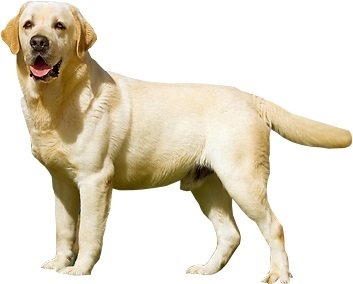
General Information
It is the most popular breed known in India. It is a fast-maturing breed that has an average life span of 10-12 years. They were not only known as family companions but also for tracking, hunting, watchdog, police work etc. It has soft flapped ears, a thick tail and water water-resistant coat. The coat has short hairs and is found in four coats i.e. black, yellow, chocolate and silver. This breed attains a height of 1 foot 9 inches – 2 feet. The average weight of the male lab is 30-35kg and that of the female lab is 25-30kg. They need to be taken on long walks, jog or run daily. If exercise is not given properly they become lethargic or gain weight. This breed gives birth to 5-10 puppies.
Fodder
Food amount or variety depends upon the age and breed of the dog. Small breeds require less amount of feed as compared to large breeds. Food in proper amounts should be given otherwise the dog will become lethargic and obese. A balanced diet that contains carbohydrates, fats, proteins, vitamins, and trace elements is required for the pet to keep it healthy and in good shape. The dogs required 6 essential elements such as fats, minerals, vitamins, carbohydrates, water and protein. Among all of these, it requires clean water all the time. The puppy needs 29% protein and the adult dogs need 18% protein in the diet. We can give all these essential elements by giving them high-quality dry food. It requires 2.5-3 cups of high-quality dry food per day, divided into two meals.
Precaution:
The feed which should not be given to the dog:
• Coffee: It is dangerous for pets as it will cause caffeine poisoning. The symptoms of this disease are rapid breathing, restlessness, muscle tremors and heart palpitations.
• Ice cream: Just like in humans, many dogs don’t tolerate lactose and as a result, it will cause diabetes.
• Chocolate: Chocolate contains a high amount of theobromine which is an offending substance. It will cause excessive thirst, seizures, irregular heartbeat and then sudden death.
• Alcohol: It will damage the liver and brain of the dog. It causes difficulty in breathing, coma and even death.
• Chewing gum: If the gum contains xylitol substance it will cause liver failure in dogs.
• Onions: They harm the dogs by destroying the RBCs of the dog.
• Avocado: It contains persin which upsets the stomach of the dog.
Care of the breed
Care while selecting a pup: Pup should be taken according to your need, purpose, hair coat, gender and size. Buy the pup which is 8-12 weeks old. At the time of buying check the eyes, gums, ears, tail and mouth. The eyes should be clear and bright, the gums should be pink, the tail should not be broken and there will be no signs of diarrhoea.
Shelter: Provide well well-ventilated, clean and protected living environment for the dog. Shelter must be safe from excessive rainfall winds and thunderstorms. In winter, the dogs are given blankets to protect them from cold weather and in summer, shade and cold places are required.
Water: Clean water should be available 24 hours to the dog. The utensils which are used to keep water must be cleaned thoroughly at least twice a day or more as per requirement.
Grooming: Grooming should be done twice a week. It is better to do combing and brushing every day. For short-haired breeds only brushing is required and for long-haired breeds combing should be done first followed by brushing.
Bathing: Dogs should be given a bath once in every 10-15 days. Medicated shampoos are recommended for bathing.
Care of pregnant dogs: Proper care of pregnant dogs is required to get healthy puppies. Vaccinations should be given at the proper interval before or at the time of pregnancy. The gestation period is approximately 55-72 days. A proper diet, good atmosphere, exercises and proper checkups are required during the gestation period.
Care of newborn puppies: For a few weeks of the puppy’s life; their primary activities include giving a good environment, feeding and developing good habits. Provide mother milk to the newborn pup for at least 2 months and if the mother dies or in any case puppy gets separated from the mother then a starter’s dog feed or powdered dog milk (mixed in water) is given to the puppy.
Dental care: Just like humans, dogs also need to visit the vet for a checkup of teeth after every 6-12 months. Brush your dog’s teeth with a soft brush and choose a paste that is fluoride-free as fluoride is very poisonous to dogs.
Recommended vaccines: Regular vaccinations and deworming are required to avoid health problems in the pet.
• The primary vaccination for canine distemper, canine hepatitis, corona viral enteritis, canine parainfluenza, parvovirus infection, and leptospirosis is given when the dog is 6 weeks old and then the secondary vaccination is given when the dog is between 2-3 weeks to 16 weeks old. And then the annual vaccination should be given.
• The primary vaccination for rabies disease is given when the dog is at 3 months of age, the secondary vaccination is given after 3 months of primary vaccination and then annual vaccination is given.
• A deworming dose should be given to protect your pet from harmful parasites. After every 15 days dose is given to a puppy aged 3 months or less, once in two months dose is given to a puppy aged between 6 and 12 months and then a dose is given every 3 months to a dog aged more than 1 year. The dose must vary according to the weight of the dog.
Diseases and Treatment
• Cancer: The symptoms are bad breath, lethargy, rapid weight loss, sudden lameness, loss or decrease of appetite and difficulty in breathing or urinating. The cancer is much more common in older dogs. Mainly Boston terriers, Golden Retrievers and Boxers are the breeds that develop tumors and in Great Danes and Saint Bernard breeds bone cancer is mainly found.
Treatment: Depending upon the type and stage of cancer, treatment should be given. The treatment mainly includes chemotherapy, radiation, surgery and immunotherapy.
• Diabetes: This disease is mainly caused by to lack of insulin hormone or inadequate response of insulin. The symptoms are lethargy, vomiting, chronic skin infections, blindness, dehydration, weight loss and increased urination. Mainly it is seen that diabetes is caused in dogs 6-9 years of age. In Poodles, Keeshonds, Dachshunds, standard and miniature Schnauzers, Samoyeds and Australian terrier breeds this disease is mainly found. In golden retrievers and keeshonds breeds mainly Juvenile diabetes are found.
Treatment: Insulin injections are necessary for proper blood regulation.
• Heartworm: The symptoms are bad breathing, vomiting, coughing, weight loss and fatigue. It is mainly transmitted from animal to animal through mosquitoes.
Treatment: “Adulticides” a drug is given to dog’s muscles to treat heartworm disease.
• Kennel cough: The symptoms are dry cough with a honking sound, fever and nasal discharge.
Treatment: An antimicrobial or cough suppressant is recommended to get relief from kennel cough.
• Rabies: The symptoms of rabies are hypersensitivity, fever, loss of appetite, weakness, paralysis of jaw and throat muscles, sudden death etc.
Treatment: No treatment is there to cure rabies once it appears on the dog. The disease results in sudden death.
• Parvovirus: The symptoms are loss of appetite, lethargy, severe vomiting, bloody and foul-smelling diarrhoea etc.
Treatment: Parvovirus vaccine is recommended to give to 6-8-week-old puppies and then a booster is given at the age of 16-20 weeks to prevent parvovirus disease.
• Ringworm: The symptoms are lesions that appear on the ear, paws, head forelimbs, etc. The ringworms are circular and patchy in shape. The puppies are more prone to this disease.
Treatment: Medicated shampoos or ointments are recommended to treat the ringworm.
• Canine distemper: Pups having an age of 3-6 months are more susceptible to this disease. The symptoms are vomiting, cough, diarrhoea and pneumonia.
Treatment: Antibiotics such as Chloramphenicol ampicillin or gentamicin for 5-7 days.
Prevention: First vaccination should be given when the pup is 7-9 weeks old and then the second vaccination should be given when the pup is 12-14 weeks old.
• Leptospirosis: It is a bacterial disease that is caused by Leptospira canicola and Leptospira enterohaemorrhagic. The symptoms are a rise in body temperature, vomiting and uremia.
Financial and Business expert having 30+ Years of vast experience in running successful businesses and managing finance.





